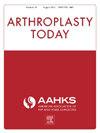骨科和感染性疾病联合假体周围关节感染临床加强关节成形术研究员培训:来自三级中心的调查
IF 2.1
Q3 ORTHOPEDICS
引用次数: 0
摘要
背景:假体周围关节感染(PJIs)发病率的上升与全关节置换术的使用增加以及肥胖、糖尿病和免疫抑制率的升高有关。尽管术前危险因素调整和围手术期抗生素干预,PJIs仍然难以预防和诊断。治疗通常需要手术和长期使用抗生素。骨科和感染性疾病(OID)联合诊所已成为管理PJIs的有效模式,但其对培训生教育的效用仍未得到充分探索。方法2020年,在报告机构建立了一个OID联合诊所,由关节置换术研究员和肌肉骨骼传染病医生组成。从2020年到2024年参加临床的14名过去的关节成形术研究员被发送了一份由10个问题组成的匿名调查,以评估他们的经历如何影响他们作为临床医生的发展及其与他们当前实践的相关性。结果:所有14名符合条件的关节置换术患者都对匿名调查做出了回应。大多数受访者(71%)从事学术实践,其他人在医院工作(21%)或私人执业(7%)。PJI病例占其临床负荷的0%-40%。共有85%的研究员报告说,多学科临床方法为他们管理PJIs做好了准备,93%的人认为这种经历对未来的研究员有益。受访者认为每月一次半天的门诊就足够了。结论throplasty医师发现联合OID临床对PJI患者的治疗有价值。奖学金项目应考虑纳入此类诊所,以加强PJI管理方面的培训。证据水平:IV级,治疗性研究。本文章由计算机程序翻译,如有差异,请以英文原文为准。
Combined Orthopaedic and Infectious Disease Periprosthetic Joint Infection Clinic Enhances Arthroplasty Fellowship Training: A Survey From a Tertiary Center
Background
The rising incidence of periprosthetic joint infections (PJIs) is linked to increasing utilization of total joint arthroplasty and higher rates of obesity, diabetes, and immunosuppression. Despite preoperative risk factor modification and perioperative antibiotic interventions, PJIs remain difficult to prevent and diagnose. Treatment typically requires surgery and prolonged antibiotics. A combined orthopaedics and infectious disease (OID) clinic has emerged as an effective model for managing PJIs, but its utility for trainee education remains underexplored.
Methods
In 2020, a combined OID clinic was established at the reporting institution, staffed by arthroplasty fellows and musculoskeletal infectious disease physicians. Fourteen past arthroplasty fellows who participated in the clinic from 2020 to 2024 were sent an anonymous survey consisting of 10 questions to evaluate how their experience influenced their development as clinicians and its relevance to their current practice.
Results
All 14 eligible past arthroplasty fellows responded to the anonymous survey. Most respondents (71%) were in academic practice, with others in hospital employment (21%) or private practice (7%). PJI cases comprised 0%-40% of their clinical load. A total of 85% of fellows reported that the multidisciplinary clinic approach prepared them for managing PJIs, and 93% felt this experience would be beneficial for future fellows. Respondents agreed that a half day clinic once per month was sufficient.
Conclusions
Arthroplasty fellows found the combined OID clinic valuable for managing PJI patients in their practice. Fellowship programs should consider incorporating such clinics to enhance training in PJI management.
Level of evidence
Level IV, Therapeutic Study.
求助全文
通过发布文献求助,成功后即可免费获取论文全文。
去求助
来源期刊

Arthroplasty Today
Medicine-Surgery
CiteScore
2.90
自引率
0.00%
发文量
258
审稿时长
40 weeks
期刊介绍:
Arthroplasty Today is a companion journal to the Journal of Arthroplasty. The journal Arthroplasty Today brings together the clinical and scientific foundations for joint replacement of the hip and knee in an open-access, online format. Arthroplasty Today solicits manuscripts of the highest quality from all areas of scientific endeavor that relate to joint replacement or the treatment of its complications, including those dealing with patient outcomes, economic and policy issues, prosthetic design, biomechanics, biomaterials, and biologic response to arthroplasty. The journal focuses on case reports. It is the purpose of Arthroplasty Today to present material to practicing orthopaedic surgeons that will keep them abreast of developments in the field, prove useful in the care of patients, and aid in understanding the scientific foundation of this subspecialty area of joint replacement. The international members of the Editorial Board provide a worldwide perspective for the journal''s area of interest. Their participation ensures that each issue of Arthroplasty Today provides the reader with timely, peer-reviewed articles of the highest quality.
 求助内容:
求助内容: 应助结果提醒方式:
应助结果提醒方式:


